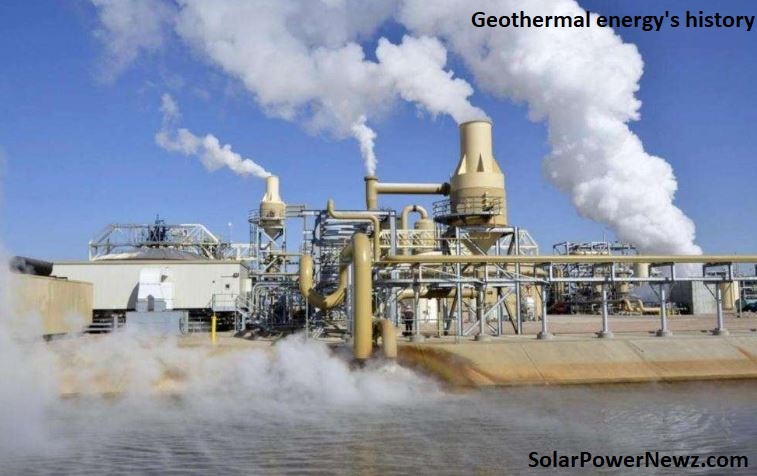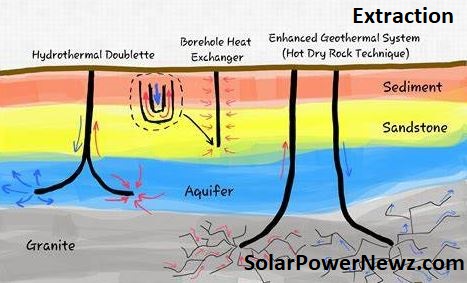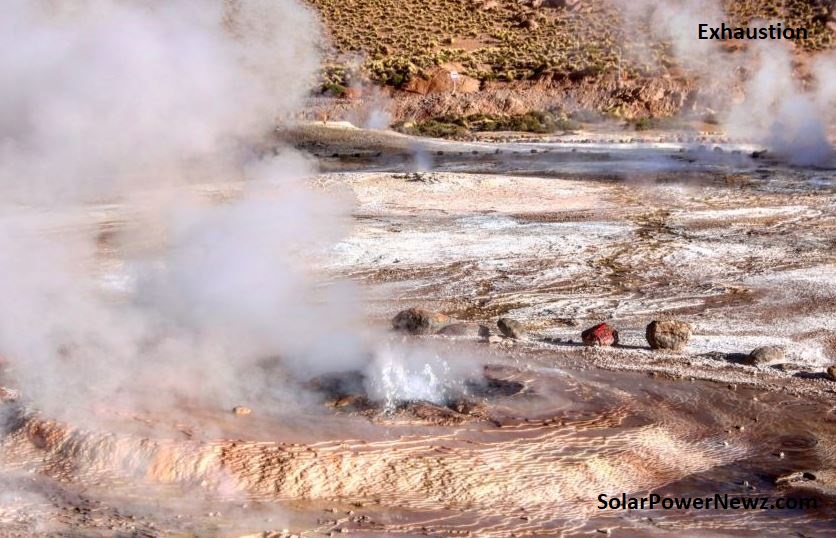Geothermal energy’s history
In this article we will discuss about Geothermal energy’s history & 10 Important key factor. For centuries, geothermal energy from natural pools and hot springs has been used for cooking, bathing, and heating. Native Americans used geothermal energy for cooking as early as 10,000 years ago, according to data. Baths heated by hot springs were utilised by the Greeks and Romans in ancient times, and examples of geothermal room heating may be found as far back as the Roman city of Pompeii in the first century CE. Such geothermal energy applications were initially restricted to areas with access to hot water and steam.
Although the world’s first district heating system was established at Chaudes-Aigues, France, in the 14th century, other cities and industries did not understand the economic potential of geothermal resources until the late 19th century. Geothermal heat was initially delivered to a residence in the United States in 1892, to Warm Springs Avenue in Boise, Idaho, and by 1970, the majority of the city was using geothermal heat. Reykjavik, Iceland, has the largest and most famous geothermal district heating system, with 99 percent of the city receiving geothermal water for space heating since the 1930s. Among the first industrial direct-use uses was the extraction of borate compounds from geothermal fluids in Larderello, Italy, in the early nineteenth century.

Table of Contents
Larderello was also the site of the first geothermal electric power generation, with the construction of an experimental plant in 1904. The first commercial application of that technology occurred in 1913, with the installation of a plant producing 250 kilowatts (kW). Geothermal power stations were first installed in New Zealand in 1958, and in northern California at the Geysers in 1960. The plants in Italy and America were dry steam facilities, with low-permeability reservoirs producing solely steam. High-temperature and high-pressure water, on the other hand, occurs naturally in New Zealand as a mixture of 80% superheated water and 20% steam. The steam generated directly from the earth is immediately utilised to generate electricity. Pipes transport it to the power plant. In contrast, superheated ground water is separated from the mixture and flashed into steam. Most geothermal facilities today are of the “wet steam” variety.
By 2015, over 80 nations were using geothermal energy, either directly or in cooperation with GHPs, with China, Turkey, Iceland, Japan, Hungary, and the United States leading the way. In 2015, the total worldwide installed capacity for direct use was approximately 73,290 megawatts thermal (MW), utilising approximately 163,273 gigawatt-hours per year (587,786 terajoules per year), yielding an annual utilisation factor of 28 percent in the heating mode—the annual energy produced by the plant (in megawatt-hours) divided by the installed capacity of the plant (in megawatts [MW]) multiplied by 8,760 hours.
In the early twenty-first century, geothermal energy was used to generate electricity in 24 nations, with the United States, the Philippines, Indonesia, Mexico, New Zealand, and Italy leading the way. In 2016, the total installed capacity for electrical power generating worldwide was approximately 13,400 MW, producing approximately 75,000 gigawatt-hours per year with a utilisation factor of 71%. (equivalent to 6,220 full-load operating hours annually). Many geothermal resources have utilisation factors of approximately 95% (equal to 8,322 full-load operational hours per year), the greatest of any renewable energy source. Before being pumped back into the reservoir, “waste” fluid from the power plant is frequently used for lower-temperature purposes, such as the bottom cycle in a binary-cycle plant. In the United States, Iceland, and Germany, such cascaded uses are common.
Extraction
Geothermal energy thrives in places with steep temperature gradients. These gradients can be found in locations damaged by recent volcanism, along plate boundaries (such as the Pacific Ring of Fire), or in areas characterised by thin crust (hot spots), such as Yellowstone National Park and the Hawaiian Islands. Geothermal reservoirs in those areas must have a heat source, sufficient water recharge, a reservoir with suitable permeability or faults that allow fluids to rise near to the surface, and an impermeable caprock to prevent heat escape. Furthermore, such reservoirs must be economically viable (that is, within the range of drills).

The hot fluid from a geothermal resource is tapped by digging wells, which can reach depths of up to 9,100 metres (approximately 30,000 feet), and is retrieved by pumping or spontaneous artesian flow (where the weight of the water forces it to the surface). Water and steam are then piped to a power plant to create electricity, or to heating and cooling purposes via insulated pipelines that can be buried or installed aboveground. Pipelines in electric power plants are typically limited to 1.6 km (1 mile) in length in order to prevent heat loss in the steam. Direct-use pipes spanning several tens of kilometres, on the other hand, have been erected with a temperature loss of less than 2-5 °C (3.6-9 °F), depending on flow rate. To reduce the cost of constructing long pipelines, the most cost-effective facilities are positioned close to the geothermal resource. In the instance of electric power generation, prices can be kept low by placing the plant near transmission lines that transport the electricity to the market.
Exhaustion
If the pace of heat extraction exceeds the rate of natural heat recharging, geothermal resources might be depleted. Geothermal resources can typically be exploited for 20 to 30 years; however, energy output may drop over time, rendering further development uneconomical. Geothermal electric power, on the other hand, has been continuously produced from the Larderello geothermal area from the early 1900s and at the Geysers since 1960. Although both of those fields have declined, the problem has been mitigated in part by drilling new wells and replenishing the water supply. Electrical capacity at the Geysers fell from 1,800 MW to around 1,000 MW, but roughly 200 MW of capacity was restored by putting the field under one operator and building pipelines to carry wastewater for reservoir replenishment. Projects like the Reykjavik district heating system have been in operation since the 1930s with no variation in output, and the Oregon Institute of Technology geothermal heating system has been in operation since the 1950s with no variation in output. Thus, with good management, geothermal resources can be sustainable for many years and even recover if use is temporarily halted.

Environmental consequences and economic costs
Changes in land use connected with exploration and plant building, noise and sight pollution, outflow of water and gases, formation of bad odours, and soil subsidence are all environmental repercussions of geothermal development and power generation. Most of these consequences, however, may be addressed with modern technology, resulting in geothermal usage having just a minor environmental impact. Klamath Falls, Oregon, for example, has roughly 600 geothermal wells for domestic space heating. The city has also invested in a district heating system and a snow-melting system in downtown, as well as providing heating to local businesses. However, none of the geothermal energy supply and delivery infrastructure are visible in town.
Furthermore, because they employ shallow geothermal resources within 100 metres (approximately 330 feet) of the surface, GHPs have a very low environmental impact. GHPs only induce minor temperature changes in groundwater or rocks and soil. The ground temperature around vertical boreholes is somewhat increased or decreased in closed-loop systems; the direction of the temperature change is determined by whether the system is dominated by heating (as in colder places) or cooling (which would be the case in warmer regions). Ground temperatures will stay constant with balanced heating and cooling loads. The temperatures on the ground will remain constant. Similarly, open-loop systems employing groundwater or lake water would have little effect on temperature, particularly in areas with high groundwater flows.
When compared to other renewable energy sources, the fundamental advantage of geothermal energy is that its base load is available 24 hours a day, seven days a week, whereas solar and wind are only available around one-third of the time. Furthermore, geothermal energy costs between 5 and 10 cents per kilowatt-hour, making it competitive with other energy sources such as coal. The biggest disadvantage of developing geothermal energy is the expensive initial investment cost in creating the facilities and infrastructure, as well as the significant risk of proving the resources. (Geothermal resources are frequently discovered in low-permeability rocks, and exploratory activities frequently drill “dry” holes—that is, holes that release steam in volumes too small to be economically exploited.) However, once the resource has been confirmed, the annual cost of fuel (hot water and steam) is modest and does not tend to rise in price.
Geothermal energy’s 10 Important key factor
10 important factors to consider when it comes to geothermal energy:
- Geothermal energy is a renewable energy source since it is produced using the Earth’s natural heat, which is constantly replenished.
- Sustainability: Geothermal energy is a sustainable energy source because it doesn’t emit any hazardous gases or other pollutants.
- Geothermal energy can produce electricity seven days a week, twenty-four hours a day, which makes it a dependable source of energy.
- Efficiency: Geothermal power plants have a high energy conversion efficiency, usually between 30% and 50%.
- Geothermal energy is versatile and can be utilised to generate electricity, heat homes, and cool them.
- Cost: Establishing a geothermal system may be more expensive initially than installing other types of systems, but because to its high efficiency and low operating costs, it can result in long-term cost benefits.
- Location: Due to the need for specific geothermal resources, like hot springs or geysers, geothermal energy is not available everywhere.
- The possibility of earthquakes and the production of hydrogen sulphide gas are two potential environmental effects linked with the extraction and use of geothermal energy, despite the fact that it is a clean and sustainable energy source.
- Technological advancements: Geothermal energy systems are becoming more efficient and effective as a result of ongoing technological advancements.
- Government laws and regulations have a big impact on the creation and application of geothermal energy.
Geothermal energy’s advantages and disadvantages
some advantages and disadvantages of geothermal energy:
Advantages
- Geothermal energy is a renewable energy source since it is produced using the Earth’s natural heat, which is constantly replenished. Because it doesn’t emit any hazardous emissions or greenhouse gases, it is also a sustainable energy source.
- Geothermal energy can produce electricity seven days a week, twenty-four hours a day, making it a dependable source of energy.
- Effective: The energy conversion efficiency of geothermal power plants is excellent, often ranging between 30% and 50%.
- Geothermal energy is versatile; it can be utilised to generate electricity and to heat and cool buildings.
- Minimal running expenses: A geothermal system offers low operating costs after installation because of its great efficiency.
Disadvantages
- High initial costs: Installing a geothermal system can be expensive, particularly if drilling is necessary.
- Limited availability: Because it needs specific geothermal resources, such hot springs or geysers, geothermal energy is not available everywhere.
- Environmental effects: The usage and extraction of geothermal energy may have an effect on the environment, including the possibility of earthquakes and the production of hydrogen sulphide gas.
- Geothermal energy has a limited potential because there aren’t enough adequate geothermal resources available.
- Geothermal energy systems are dependent on technology, which can be costly and require maintenance.